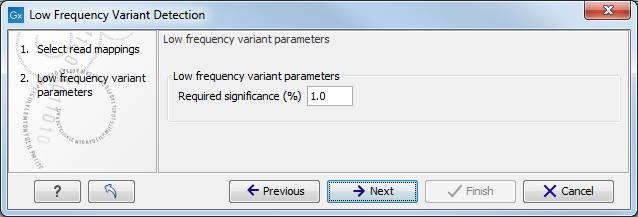Low Frequency Variant Detection
As the Fixed Ploidy Variant Detection tool, the Low Frequency Variant Detection tool relies on
- A statistical model for the analyzed sample and
- A model for the sequencing errors.
A statistical test is performed at each site to determine if the nucleotides observed in the reads at that site could be due simply to sequencing errors, or if they are significantly better explained by there being one (or more) alleles. If the latter is the case, a variant corresponding to the significant allele will be called with an estimated frequency.
The Low Frequency Variant Detection tool has one parameter (figure 28.6):
- Required Significance: this parameter determines the cut-off value for the statistical test for the variant not being due to sequencing errors. Only variants that are at least this significant will be called. The lower you set this cut-off, the fewer variants will be called.
The Low Frequency Variant Detection tool is suitable for analysis of samples of mixed tissue types (such as cancer samples) in which low frequent variants are likely to be present, as well as for samples for which the ploidy is unknown or not well defined. The tool also calls more abundant variants, and can be used for analysis of samples with ploidy larger than four. Note that, as the tool looks for all variants, abundant as well as low frequency ones, analysis will generally be slower than those of the other variant detection tools. In particular it will be very slow - possibly prohibitively so - for samples with extremely high coverage, or a very large number of variants (as in cases where the sample differs considerably from the reference).

Figure 28.6: The Low Frequency Variant Detection parameters.
For a more in depth description of the Low Frequency Variant Detection tool see Detailed descriptions).
